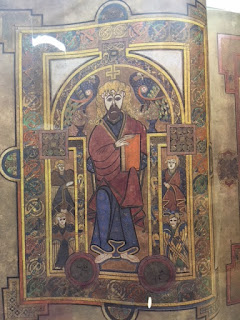We did not go to either of these.
Instead we over the famous bridge ("Ponferrada" means iron bridge) and up to Ponferrada's castle, which has fairly recently seen enough renovations to understand what life must have been like in this prominent edifice. Originally there was a Roman fort here, over which was built a Visigoth fort. At some point, the fort's ruins were given to the Knight's Templar, which built this fabulous castle in short order, (considering the era), only to see their order dissolve 20 years after the castle was completed.
The castle was occupied and added to over the centuries and is 16,000 square metres of solid defense. Like other castles, it was also a palace, a monastery, and a city, complete with cemetery and stables, kitchens and sleeping quarters for hundreds of people. And of course there was the requisite dungeon for those that did not play nice with others. Wandering around and looking out over the river far below or across to the mountains we had recently walked through took a good chunk of time, but it is what was inside that kept us there for three hours.
There was an excellent exhibit of what life was like for everyone during the times, the roles that were played and the clothing that would have been worn by each sector of person. In those earliest of days one was either connected to the church as a scholar or clergy, or was a craftsperson engaged in the constant construction industry, or worked in the fields in some agricultural capacity. Or one was a woman.
Honestly, those poor women! They were married off young, spent half their life pregnant, expected to lose half their children before they reached the age of 1, and then often died early themselves. They had no chance of developing any sort of artistic or intellectual ability or being involved in the running of their world. I said a prayer for all their souls, and apologized on behalf of humanity that they had such a rum deal. I also thanked them for keeping the human race alive.
Once I'd gotten that out of my system, I did learn a few things that did interest me. For starters, in the Middle Ages there were no architects. The concept was completely unknown at the time. That means that these incredible castles were built without a designer, without a plan. All the master builders would have instead approached the project with spontaneity and deal with problems or issues as they arose.
Not only that, but the basic tools used were only three: the fixed compass, the square and the cord. The cord, known as the "druids' string" was the most important. It was a piece of ordinary rope on which thirteen knots were made at equidistant lengths, which created 12 identical segments. As the museum put it "it is quite surprising how many geometric and mathematical problems can be solved but also somewhat alarming that this simple measuring device was used to build castles."
The other time sucker of joy was the Templars' Library. This wonderful building presented books, some original and some exact copies, of the most prized and ancient books in history: 12th century bibles, medaieval books of days owned by the Medici family, the Gutenberg Bible, the Book of Kells, the Song of Roland, Don Quixote, on and on. We gazed at some of the pages full of colour and light and marvelled at their age (if they were original) and their execution (if copied). We wondered what a 15th century pilgrim would have felt having access to such riches on their journey to Santiago.
 |
| a map of the world..... |
 |
| ...with a somewhat embarrassed Adam and Eve |
 |
| this one is called Flamenco Apocalypse! |
 |
| a Book of Kells hipster |
 |
| the book of books, Gutenberg bible |
 |
| same illustration as the next, but tilted... |
 |
| ...to show the marvelous goldwork |
 |
| My favourites. I love how the illustrator has placed characters outside of the box |
 |
| especially this one, with someone hanging off a catapult, and the archer shooting from the tower above |
If there ever was such a thing as luck, then I would have it. Living now, being here.










I'm feeling educated by your travels! and I am thinking about the questions I'm going to ask on our Camino edition of Flotsam & Jetsam!
ReplyDeletehaha - bring them on!
ReplyDelete